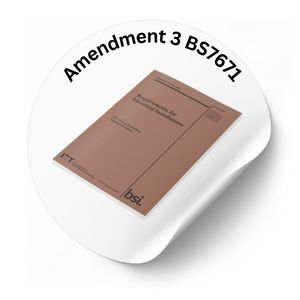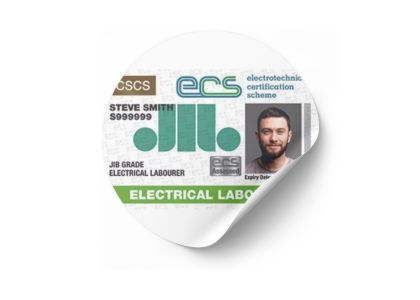
18th Edition - BS7671 Wiring Regulations
Helping You Prepare For Amendment 3
These recent posts might interest you…
Let’s look at the upcoming Amendment 3 to the 18th Edition Wiring Regulations. Scheduled for release in the summer of 2024. This amendment introduces several important updates. This post will guide you through these changes, their impact on your current qualifications, and the steps you need to take to stay compliant.
The good news first.
No new regulations book is needed, and if you already hold the latest version of the Wiring Regulations qualification C&G 2382-22, there is no new exam to take.
Topics we will look at in this post:
- Understanding Amendment 3.
- Updating your regs book (needs to be the brown A2 version).
- Impact on 18th Edition exam and your current qualifications.
Topic 1. Understanding Amendment 3 of BS7671
What is Amendment 3?
Amendment 3 is a set of modifications to the 18th Edition Wiring Regulations 2022 (brown book). It updates the existing regulations rather than introducing a new edition.
A new edition, The 19th Edition Wiring Regulations, will be published in a few years following Amendment 3. There is no planned date for the 19th Edition Wiring Regulations, but based on historical release dates, we would expect this to be in around 2 – 4 years time.
Key Changes:
- Introduction of Regulation 530.3.201.
- Focus on the direction of power flow in protective devices.
- Requirement for bidirectional protective devices where applicable.
Rationale Behind the Amendment
Industry Concerns
Trade associations identified issues with unidirectional protective devices being used inappropriately. These devices, such as RCDs and RCBOs, could malfunction if power flows in the wrong direction.
Regulatory Response
The new regulation mandates that equipment for protection, isolation, switching, and monitoring must account for all potential directions of power flow. Only bidirectional devices should be used where necessary.
New Definitions for BS7671 (Part 2 of BS7671)
Definition: Unidirectional Protective Devices
Devices that allow power flow in one direction only, such as certain RCDs and AFDDs. These are marked with directional indicators like line and load.
Definition: Bidirectional Protective Devices
Devices that permit power flow in either direction. Examples include some RCCBs. If unmarked, these devices can handle power flow in both directions.
Practical Examples:
- Bidirectional Flow: Charging an electric vehicle at home (power flows to the vehicle). If you recharge it elsewhere and plug it back into your house, power flows from the vehicle to the building. The protective device in such a circuit must handle power flowing in both directions.
- Unidirectional Flow: An electric kettle which only draws power from the socket without sending it back.
The Proposed Amendment
Regulation 530.3.201 specifies that where bidirectional power flow is possible, only a suitable device for bidirectional power flow shall be used. The note at the end clarifies that unmarked devices can be assumed to be bidirectional. The amendment also includes two new definitions in Part Two of BS7671: bidirectional protective device and unidirectional protective device.
Topic 2. Updating Your Regs Book
Effective Date
Amendment 3 becomes mandatory immediately upon its release in the summer of 2024. There will be no transitional period between Amendments 2 and 3.
Updating Your Book
No New Book Required: If you own the brown Amendment 2 book, you can simply download and print the Amendment 3 document from the IET website.
Practical Tip: Print a copies of the Amendment from the IET’s website. Cut out sections from the other to paste into your existing copy of BS7671 2022 (brown book).
Topic 3. Impact on 18th Edition Exam and Your Current Qualifications
Exam Transition Period
-
Current Students: Those already enrolled in a BS7671 exam course will have a grace period to complete their exams under Amendment 2.
-
Future Exams: After a short transition, all exams will be based on Amendment 3. The changes are straightforward and should not pose significant difficulties.
Retaking Exams
-
17th Edition (yellow book) C&G 2382-15 or earlier certificate holders: You will need to update to the latest brown book version of BS7671. City & Guilds 2382-22 qualification. MJ Electrical Training offers an industry-leading online 18th edition training course with an exam package for only £234.00 Inc VAT.
-
18th Edition (blue book) C&G 2382-18 certificate holders: You will need to update to the latest brown book version of BS7671. City & Guilds 2382-22. MJ Electrical Training offers an exam-only option for persons who currently hold the City & Guilds 2382-18 (blue book) qualification for only £174.00 Inc VAT.
-
18th Edition (brown book) C&G 2382-22 certificate holders. No need to retake the examination. Your qualifications are deemed up to date, and your existing knowledge and experience are sufficient to incorporate the new changes.
Impact on Periodic Inspections
Existing Installations: Trade bodies are evaluating the amendment’s impact on existing installations and will develop appropriate classification codes for EICRs.
Resources and Support
-
Free Download: The Amendment document will be available for free on the IET website.
-
Additional Training Materials: MJ Electrical Training will update their current 18th edition training material to reflect the Amendment and release a blog post explaining the Amendment in detail with sample exam questions similar to those in the 18th Edition City & Guilds final exam.
Conclusion
This is a straightforward Amendment. It is expected to be published in the summer of 2024 as a free download from both the IET and BSI websites. Unlike the last Amendment (the brown book in 2022), which replaced the previous version of BS7671, this Amendment will supplement the existing brown book. Together, they will form the up-to-date version of BS7671. This Amendment is to be used immediately upon publication.





